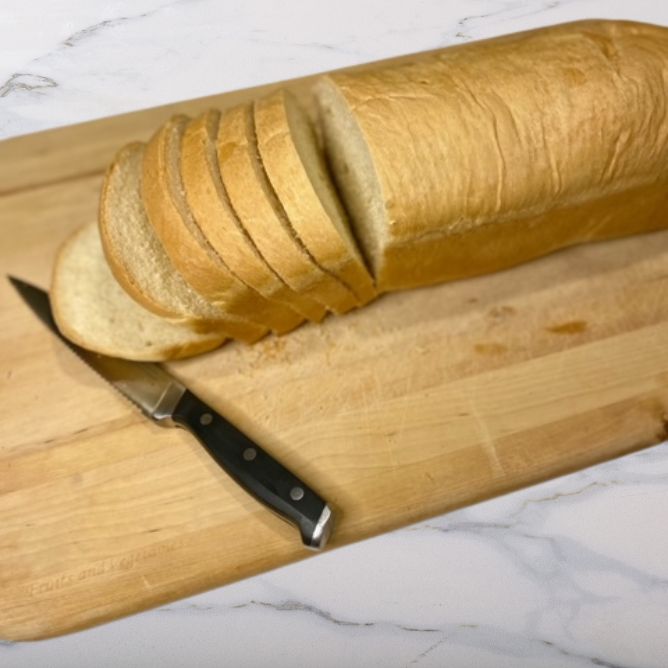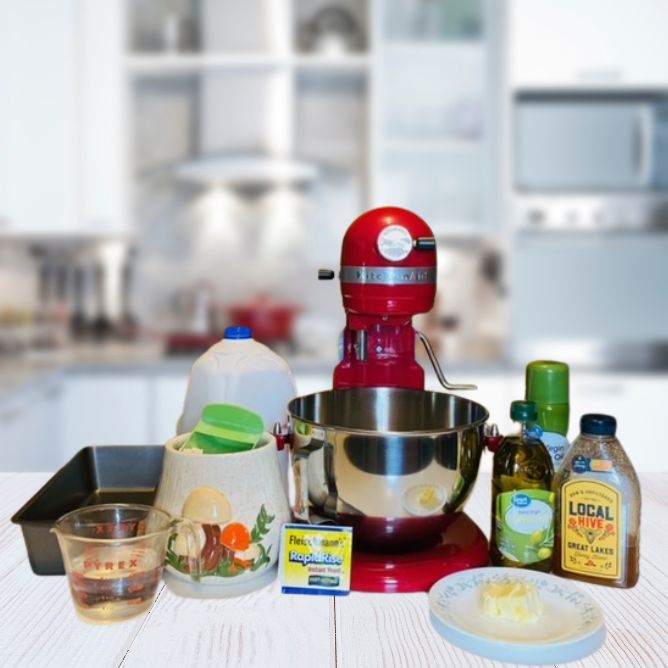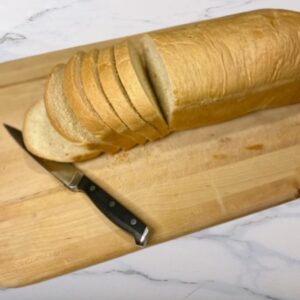Savor the Flavor: Low Sodium Sandwich Bread for Healthier Bites!”

Homemade Low Sodium Sandwich Bread: Perfect for Every Meal
Are you looking for a delicious, low sodium bread recipe that’s perfect for sandwiches and more? Look no further! With just a few simple ingredients you can make your own homemade sandwich bread that’s soft, flavorful, and low in sodium. This recipe is easy to follow and yields a loaf that will quickly become a staple in your kitchen.
This post may contain affiliate links, please see our Privacy Policy for more information.
Why Make Low Sodium Bread?
Many store bought breads contain a surprising amount of sodium, which can be a concern for those watching their salt intake. Making your own bread at home allows you to control the ingredients and keep the sodium content low, without sacrificing flavor or texture. This homemade bread is perfect for sandwiches, toast, or just enjoying with a bit of unsalted butter.
Ingredients:

- 1 cup water, warmed to about 125°F (52°C)
- 1/4 cup milk, warmed to about 125°F (52°C)
- 1 packet instant yeast (2-1/4 teaspoons)
- 1/4 cup honey or granulated sugar
- 4 tablespoons unsalted butter, softened to room temperature
- 3-1/3 cups all-purpose flour or bread flour, plus more as needed
Making it:
- Prepare the Liquid Mixture:
- Warm the water, milk, and honey (or sugar) to about 125°F (52°C). You can use a microwave or stove top for this. Ensure the temperature is correct using a kitchen thermometer to avoid killing the yeast.
- Activate the Yeast:
- In the bowl of your stand mixer, combine the warmed water, milk, and honey (or sugar) mixture. Stir until the honey (or sugar) is dissolved.
- Sprinkle the instant yeast over the liquid mixture and lightly stir.
- Cover the bowl with a clean towel and let sit for about 5 minutes until it becomes foamy. This indicates that the yeast is active.
- Add Butter and Flour:
- Add the softened unsalted butter and 1 cup of flour to the bowl.
- Using the paddle attachment of your stand mixer, mix on low speed until mostly combined (the butter will still be a little chunky).
- Gradually add the remaining flour, one cup at a time, to the bowl.
- Mix on low speed after each addition until the dough starts to come together.
- Knead the Dough:
- Switch to the dough hook attachment. Knead the dough on medium speed for about 8-10 minutes. The dough should be smooth and elastic. If the dough is too sticky, add a little more flour, one tablespoon at a time, until the desired consistency is reached.
- First Rise:
- Lightly grease a large bowl with oil or non-stick spray. Place the dough in the bowl, turning it to coat all sides. Cover the bowl with a clean kitchen towel or plastic wrap.
- Let the dough rise in a warm, draft-free area for about 1-2 hours, or until it has doubled in size.
- Shape the Dough:
- Once the dough has risen, gently punch it down to release the air. Transfer the dough to a lightly floured surface and shape it into a loaf.
- Second Rise:
- Bake the Bread:
- Preheat your oven to 350°F (175°C).
- Once the dough has risen, remove the cover and place the loaf pan in the preheated oven.
- Bake for about 30-35 minutes, or until the bread is golden brown and sounds hollow when tapped on the bottom. If the top of the bread is browning too quickly, you can tent it with aluminum foil halfway through baking.
- Cool the Bread:
- Remove the bread from the oven and let it cool in the pan for about 10 minutes. Then transfer the loaf to a wire rack to cool completely before slicing.
Uses for Your Low Sodium Sandwich Bread:
- Classic Sandwiches: Perfect for low sodium ham and Swiss cheese, low sodium turkey and avocado, or your favorite low sodium deli meats and veggies.
- Toast: Enjoy with unsalted butter, jam, or avocado for a delicious breakfast or snack.
- French Toast: Make a healthier version of this breakfast favorite by using your low sodium bread.
- Croutons: Cube and toast for salads or soups.
Share Your Thoughts!
I hope you enjoy making and savoring this low sodium sandwich bread as much as I do. It’s a versatile and healthier option that’s perfect for all your bread needs. We’d love to hear how your baking experience went! Did you try any variations or have any tips to share? Please leave a comment below with your thoughts, questions, and any feedback on the recipe. Happy baking, and enjoy your delicious homemade bread!

Low Sodium Sandwich Bread
Equipment
- 1 stand mixer optional
- 1 13×5 bread loaf pan or two 9×5 loaf pans
- 1 baking thermometer
- 1 wire rack
Ingredients
- 1 cup water warmed to about 125°F (52°C)
- 1/4 cup milk warmed to about 125°F (52°C)
- 1 pkt Instant yeast packet or 2-1/4 tsp instant yeast
- 1/4 cup honey or granulated sugar
- 4 Tbsp unsalted butter softened to room temperature
- 3-1/3 cups all-purpose flour or bread flour plus more as needed
Instructions
- Warm the water, milk and honey (or sugar) to about 125°F (52°C). You can use a microwave or stove top for this. Ensure the temperature is correct using a kitchen thermometer to avoid killing the yeast.
- In the bowl of your stand mixer, combine the warmed water milk and honey (or sugar) mixture. Stir until the honey (or sugar) is dissolved.
- Sprinkle the instant yeast over the liquid mixture. Lightly stir.
- Cover bowl with a clean towel and let sit for about 5 minutes until it becomes foamy. This indicates that the yeast is active.
- Add the softened unsalted butter and 1 cup of flour to the bowl. Using the paddle attachment of your stand mixer, mix on low speed until mostly combined. (the butter will still be a little chunky)
- Gradually add the remaining flour, one cup at a time, to the bowl. Mix on low speed after each addition until the dough starts to come together.
- Switch to the dough hook attachment. Knead the dough on medium speed for about 8-10 minutes. The dough should be smooth and elastic. If the dough is too sticky, add a little more flour, one tablespoon at a time, until the desired consistency is reached.
- Lightly grease a large bowl with oil or non-stick spray. Place the dough in the bowl, turning it to coat all sides. Cover the bowl with a clean kitchen towel or plastic wrap.
- Let the dough rise in a warm, draft-free area for about 1-2 hours, or until it has doubled in size.
- Once the dough has risen, gently punch it down to release the air. Transfer the dough to a lightly floured surface and shape it into a loaf.
- Preheat your oven to 350°F (175°C).
- Once the dough has risen, remove the cover and place the loaf pan in the preheated oven. Bake for about 30-35 minutes, or until the bread is golden brown and sounds hollow when tapped on the bottom.
- If the top of the bread is browning too quickly, you can tent it with aluminum foil halfway through baking.
- Remove the bread from the oven and let it cool in the pan for about 10 minutes. Then transfer the loaf to a wire rack to cool completely before slicing.
- Enjoy your homemade low sodium bread!
Notes
Disclosure: This post may contain affiliate links. Please note that I may earn from qualifying purchases. This means if you click on an affiliate link and make a purchase, I may receive a small commission at no additional cost to you. Please read the privacy policy for more information.Thank you for supporting my blog!

1 thought on “Savor the Flavor: Low Sodium Sandwich Bread for Healthier Bites!””